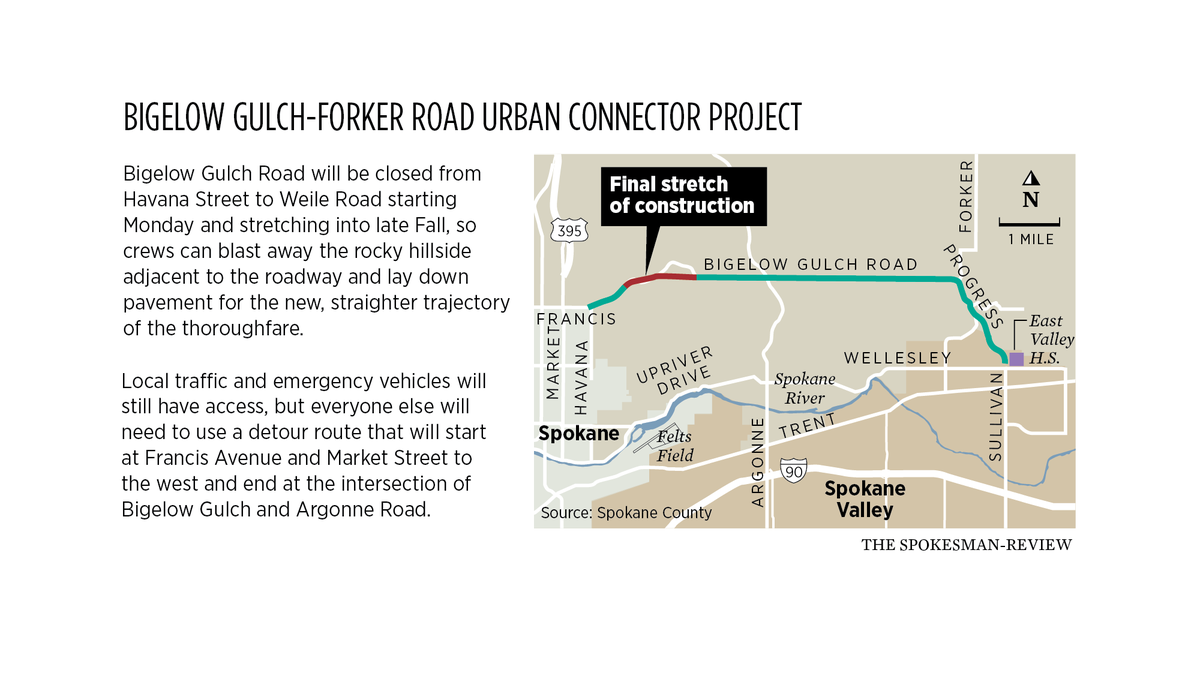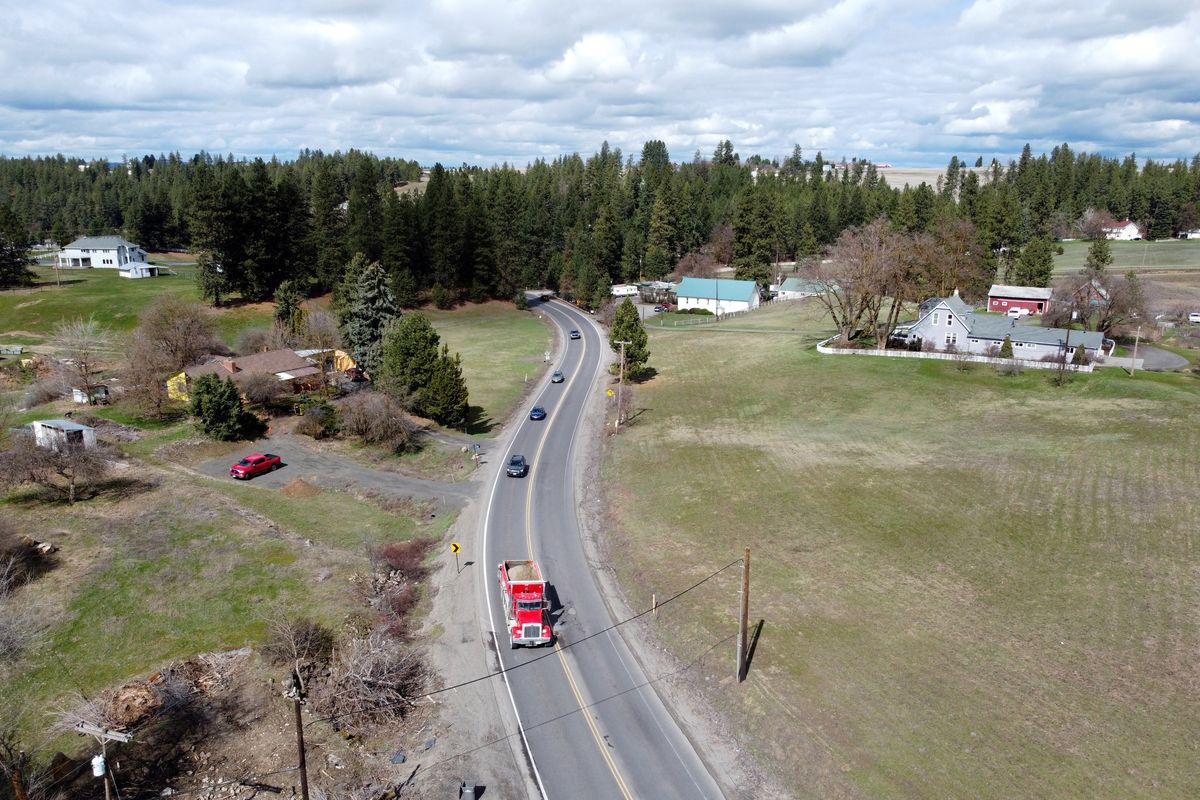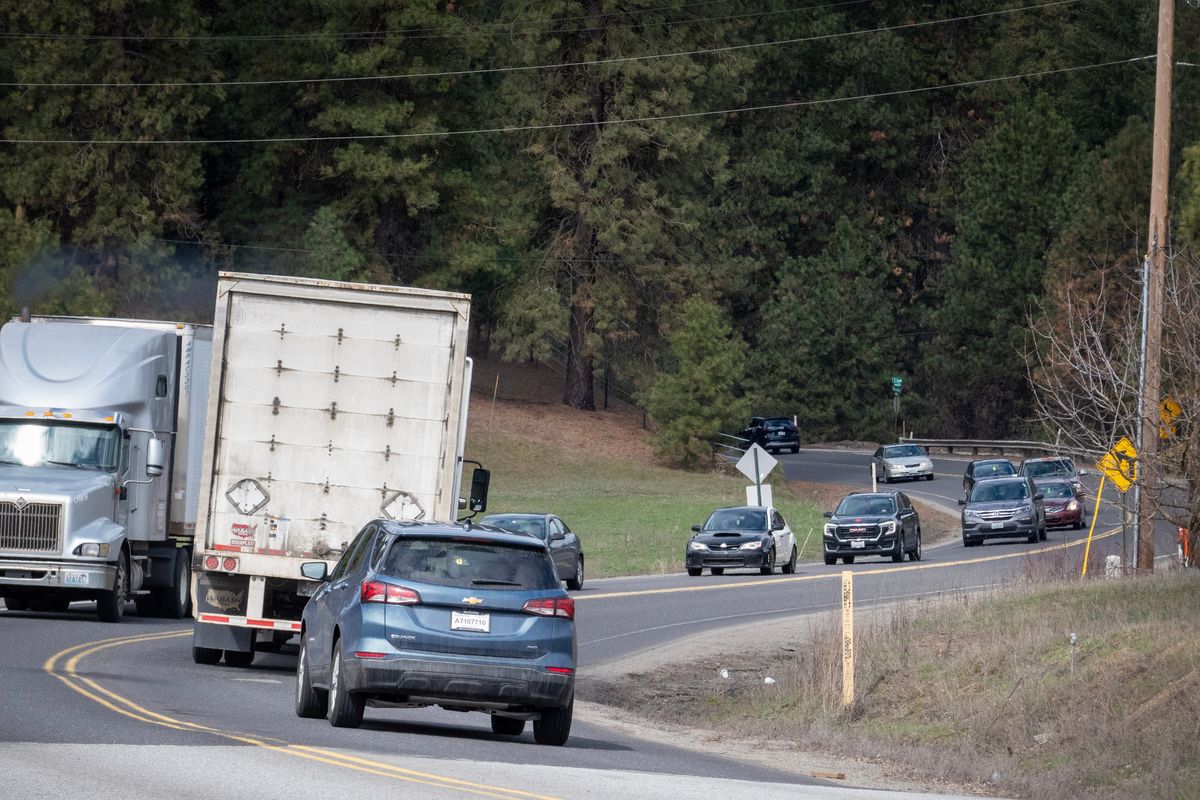Getting There: Spokane County begins work on final stretch of Bigelow Gulch project
Bigelow Gulch Road, just west of Weile Road, winds past the Central Grange Hall, center, on its track from Hillyard to its crossroad with Argonne Road, a section that will close this week and get rebuilt with straighter stretches and more lanes for safety, shown Friday, March 29, 2024. It will be closed to traffic at least until October of this year. (Jesse Tinsley/THE SPOKESMAN-REVIEW)
Spokane County work crews will resume construction of the final stretch of the Bigelow Gulch-Forker Road Urban Connector on Monday, bringing a nearly quarter-century and $81 million effort to a close.
The controversial expansion and straightening of the winding 8 miles of scenic roadway through the rolling agricultural lands of Orchard Prairie has been underway longer than a quarter of Spokane residents have been alive, according to U.S. Census data.
The county split the work into nine phases and finished seven of them between 2005 and 2021.
County Commissioner Josh Kerns, who’s spent eight years representing the residents of the Bigelow Gulch area, said he remembers when work first got underway in 2003, while he was still a student at Mead High School.
“I didn’t know what it was about at the time,” Kerns said. “I didn’t know it was part of a much grander project, and so just to be able to see it for so many years as a constituent, as a citizen of the county, and then to be a part of bringing it home here at the end has been quite the adventure.”
Bigelow Gulch Road will be closed from Havana Street to Weile Road starting Monday and stretching into late fall so crews can blast away the rocky hillside adjacent to the roadway and lay pavement for the new, straighter trajectory of the thoroughfare.
Local traffic and emergency vehicles still will have access, but everyone else will need to use a detour route that will start at Francis Avenue and Market Street to the west and end at Bigelow Gulch and Argonne Road.
Project manager Mick Flugel said it’ll take around 250 working days for crews to move more than 200,000 cubic feet of rocks, foliage and soil, construct more than 600 feet of deep culverts, lay a cement base and asphalt for the roadway, and install guardrails, signage and lighting.
Like past phases of the Bigelow Gulch project, the final leg aims to straighten and widen the curving lanes that provide low visibility and can be hard to navigate in inclement weather. Doing so will require going over a hill, which accounts for the large amount of materials that will take an average dump truck at least 490 trips to clear out.
“We’re removing those curves completely, and it almost takes off about a half a mile of roadway there by directing it over the hillside,” said Brandi Colyar, capital projects program manager for the county’s Public Works department.
The improvements should make that stretch of Bigelow Gulch safer and friendlier for freight traffic, which are two key goals of the connector project. Colyar said a 2020 study found there was a potential for a 29% reduction in collisions on Bigelow Gulch Road through the county’s improvements.
“There’s certainly the benefits as far as a transportation corridor,” Kerns said. “But certainly, if you’ve been a resident of Spokane, Spokane County, for any period of time, you know how dangerous this final section is.”
Accommodating increasing traffic in the area was another key goal of the project, said Public Works Director Kyle Twohig. In 2006, 5,300 vehicles used the road every day east of Argonne, which approximately bisects Bigelow Gulch. Projections estimated traffic would grow to 13,700 vehicles a day by 2040. In 2015, the number was up to 7,000 vehicles a day.
Nowadays, more than 16,000 vehicles use the eastern end of the road, and more than 21,000 use the stretch west of Argonne Road, where most of the final phase of construction will take place. Between 4,000 to 5,000 trucks use the roadway as is.
“That’s a very high percentage of truck traffic,” Twohig said. “So it’s doing what it’s original intention was, actually be that heavy freight route. And so that’s really good to see. We can see a lot of trips per day, and the growth of the vehicular traffic, but the truck traffic is a really critical, important piece of that.”
A quarter-century of challenges, conflict and concerns
The Bigelow Gulch project has not been without controversy. Lawsuits, rising costs and lengthy delays have marred the more than two decades-long project.
The idea of expanding and straightening out one of the county’s most dangerous highways first arose in the mid-’90s, after its popularity as a trucking route rose alongside a rise in traffic collisions. Bigelow Gulch Road saw 175 wrecks between 1991 and 1996, alone.
Some residents of the area objected to the project, saying it would change the country, rural feel of the primarily agricultural land north of the city.
But Spokane County saw a need for the transportation, safety and economic benefits it would bring, and work got underway in 2003. The project was expected to cost around $25 million at the time, which jumped to $58 million by 2008.
Final costs are expected to be about $81.75 million, with a large portion of the funding coming from a number of partners and grants, including the federal government.
Twohig said it’s fairly impressive the jump from 2008 to present was only as large as it is, given inflation and the rising costs of construction.
“We’re really grateful that everybody chipped in on this project. It’s ertainly not something that the county could have handled on its own and nor with one or two partners,” Twohig said. “I mean, it took a tremendous amount of people to make this happen, and organizations and funding sources.”
More than $2 million of the final bill can be attributed to the land needed to realize the county’s vision of a straighter Bigelow Gulch Road. Spokane County has had to purchase dozens of strips of land for right of way, which can vary from a lane’s width to multiple acres along the curves.
In 2010, the county had its real estate acquisitions shut down after investigations determined county real estate agents violated federal standards. That held up federal grant funds and stalled the project for years.
Many property owners have accepted the county’s offer for their land, but others have refused to sell, leading the county to condemn the properties needed for the project. When the two sides can’t agree on the value of their property, the argument goes to the courts and they make their cases.
In 2019, one of those disagreements ended in court.
Spokane County offered ranchers Frank and Gloria Bingaman $10,375 for 0.4 acres along the road. The Bingamans wanted $383,000, emphasizing the land had more value for them due to their cattle operation. The jury awarded the ranchers $132,500.
Rob Dunn, co-founder of law firm Dunn & Black, said he and his partners have represented at least nine of the landowners along Bigelow Gulch Road that fought for more money from the county, including the Bingamans.
Dunn said his clients still are unhappy with the project, and what it may do to their little slice of Spokane, but the “statutes are stacked against them” as far as holding onto their properties.
“They’ve got a four -lane freeway now running through their front yard,” Dunn said. “They all hate it.”
Lawsuits over major infrastructure projects are not uncommon, particularly when it comes to disagreements over what the “fair value” of a landowner’s property is.
“The only option you have is to make sure the government pays you every nickel and dime you’re entitled to,” Dunn said.
Twohig said the county often hears concerns over how a project may change a certain area, but those concerns may not be warranted for the urban connector.
“The zoning is what controls the character of a place like that,” Twohig said. “Having safer, more efficient transportation routes doesn’t increase density. Somebody can’t just throw a big commercial center up because they feel like it, now that there’s this corridor right there.”
Kerns echoed Twohig, adding that the area is well outside the boundaries of the Urban Growth Area.
“You’re not going to see a suburban neighborhood pop up right next to it because the Growth Management Act wouldn’t allow for that,” Kerns said. “But you know, we’ve definitely had folks reach out, who have different ideas, different concepts, but I think just about everybody agrees that this will make the roadway safer.”
Other challenges have popped up over the years, like the natural spring that bubbled up through the pavement of a section of Forker Road that led to a large puddle, or ice in the winter, at the northeast end of the project. Colyar said crews had to reopen that section of pavement to address the issue.
The county also has spent more than $760,000 to mitigate the impacts of the project on neighboring wetlands, which is required by state and federal law. Colyar said they finished converting 7.2 acres of county land near Fish Lake into a marshy oasis last fall.
‘Truly blazing a new trail’
With the finish line in sight, Kerns said he looks forward to the day when the challenges and construction are in the rearview mirror. His first meeting after being elected to office focused on the Bigelow Gulch Urban Connector, and he’s grateful to have helped guide the project over the years.
“There’s benefits from economic development and then there’s certainly benefits when it comes to safety,” Kerns said. “So it checks a lot of boxes. I think it’s gonna be a huge asset for our community.”
Twohig agreed, saying projects of this scale are rare.
“In the transportation world, building a new corridor is a substantial undertaking,” Twohig said. “You’re truly blazing a new trail. And you don’t have a lot of comparable examples to this in our region, or in many regions, where you truly say ‘we’re going to undertake an entire new route as a major transportation leg in our system,’ connecting some important hubs along the way.”





